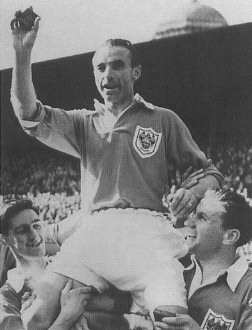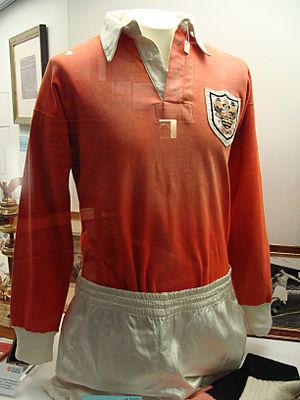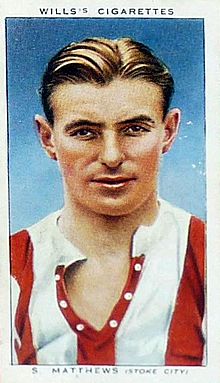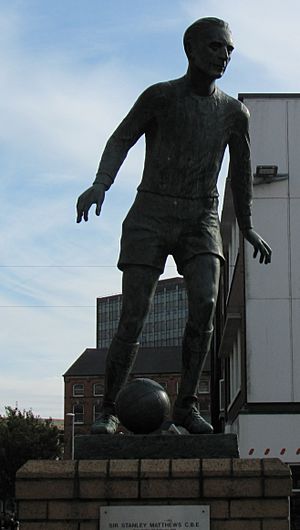Stanley Matthews facts for kids

Matthews with Blackpool FC lifting his 1953 FA Cup Final winner's medal to the sky, so that his deceased father could see it
|
|||
| Personal information | |||
|---|---|---|---|
| Full name | Stanley Matthews | ||
| Date of birth | 1 February 1915 | ||
| Place of birth | Hanley, Stoke-on-Trent, England | ||
| Date of death | 23 February 2000 (aged 85) | ||
| Place of death | Stoke-on-Trent, England | ||
| Height | 5 ft 9 in (1.75 m) | ||
| Position(s) | Outside right | ||
| Youth career | |||
| 1930–1932 | Stoke City | ||
| Senior career* | |||
| Years | Team | Apps | (Gls) |
| 1932–1947 | Stoke City | 259 | (51) |
| 1947–1961 | Blackpool | 379 | (17) |
| 1961 | → Toronto City (loan) | 14 | (0) |
| 1961–1965 | Stoke City | 59 | (3) |
| 1965 | → Toronto City (loan) | 6 | (0) |
| Total | 717 | (71) | |
| International career | |||
| 1929 | England Schoolboys | 1 | (0) |
| 1934–1956 | The Football League XI | 13 | (2) |
| 1934–1957 | England | 54 | (11) |
| 1947–1955 | Great Britain | 2 | (0) |
| Managerial career | |||
| 1967–1968 | Port Vale | ||
| *Club domestic league appearances and goals | |||
Sir Stanley Matthews (born February 1, 1915 – died February 23, 2000) was a famous English footballer. He played as an outside right, which means he played on the right side of the attack. Many people think he was one of the best British players ever.
Stanley Matthews was the only footballer to be made a "Sir" (knighted) while still playing the game. He was also the first player to win both the Ballon d'Or (European Footballer of the Year) and the FWA Footballer of the Year awards. People called him "The Wizard of the Dribble" and "The Magician" because of his amazing skills with the ball.
He was incredibly fit and played at the top level until he was 50 years old! He holds records for being the oldest player in England's top football league (50 years and 5 days) and the oldest player to play for his country (42 years and 104 days). In 2002, he was one of the first players to be put into the English Football Hall of Fame.
Matthews played for Stoke City for 19 years in two different periods (1932–1947 and 1961–1965). He helped Stoke win the Football League Second Division title twice. In between his time at Stoke, he spent 14 years with Blackpool. After losing two FA Cup finals, he finally won the cup with Blackpool in 1953. This game is still famous and is known as the "Matthews Final". In 1956, he won the first-ever Ballon d'Or award. He also played 54 games for England between 1934 and 1957, playing in two FIFA World Cups.
After retiring from playing, he worked as a general manager for Port Vale and later coached amateur teams around the world. A special part of his coaching was in South Africa in 1975. Even though there were strict apartheid laws (which separated people by race), he started an all-black team in Soweto called "Stan's Men".
Contents
Early Life and Football Dreams
Stanley Matthews was born on February 1, 1915, in Hanley, Stoke-on-Trent. He was the third of four sons. His father, Jack Matthews, was a local boxer known as the "Fighting Barber of Hanley".
When Stanley was six, his father took him to the Victoria Ground, home of Stoke City, for a children's race. His father bet on him, and Stanley won! He loved playing football at school and at home, spending hours practicing dribbling around kitchen chairs in his backyard.
Even though he later became famous for Stoke City, Stanley grew up supporting their local rivals, Port Vale. His father wanted him to be a boxer, but at 13, Stanley decided he wanted to be a footballer. His mother, Elizabeth, helped him convince his father to let him follow his dream. His father agreed, but only if Stanley was picked for England Schoolboys. Stanley played for England Schoolboys in 1929, in front of about 20,000 fans.
Playing for Stoke City
After playing for England Schoolboys, many big clubs were interested in Matthews. But Stoke City manager Tom Mather convinced Stanley's father to let him join Stoke as an office boy for £1 a week.
Stanley played for Stoke's reserve team, focusing on getting better. He developed a new dribbling technique where he would quickly swerve past defenders. On his 17th birthday, he signed as a professional player with Stoke, earning £5 a week. His father made sure he saved most of his money.
He made his first team debut on March 19, 1932, against Bury. Stoke won 1–0. In the 1932–33 season, Matthews helped Stoke become Second Division champions. He scored his first goal against local rivals Port Vale on March 4, 1933.
Stoke finished fourth in the league in 1935–36, their best finish ever. Matthews continued to improve his skills, adding the "double body swerve" to his tricks.
In 1938, Matthews asked to leave Stoke because of rumors that some teammates were jealous of his success with England. Stoke fans and the club chairman convinced him to stay. He played for Stoke until 1947, when he moved to Blackpool.
Wartime Football
World War II meant Matthews couldn't play professional football from age 24 to 30. He joined the Royal Air Force and was based near Blackpool. He played many unofficial games for Stoke and also made guest appearances for Blackpool and other clubs. He also played 29 times for England in unofficial wartime matches.
In 1945, his father passed away. On his deathbed, he made Stanley promise two things: to look after his mother and to win an FA Cup Final.
Blackpool Success

In May 1947, at 32 years old, Matthews moved to Blackpool for £11,500. Blackpool manager Joe Smith told him to play freely and express himself. Matthews joined a talented team that played exciting football.
In 1948, Matthews won the first-ever FWA Footballer of the Year award. Blackpool reached the 1948 FA Cup Final but lost 4–2 to Manchester United. They also reached the 1951 FA Cup Final but lost again.
After an ankle injury in 1951, Matthews changed his diet, cutting out red meat to become almost a vegetarian. His manager, Joe Smith, believed Matthews' best football was still to come, even at 37.
Smith was right! In the 1952–53 season, at 38, Matthews finally won an FA Cup winner's medal. In the 1953 FA Cup Final, Blackpool were losing 3–1 to Bolton with 35 minutes left. Matthews played incredibly well, helping his team score three goals to win 4–3. Even though Stan Mortensen scored a hat-trick, the match became known as the "Matthews Final" because of Stanley's amazing performance.
In 1956, Matthews won the first-ever European Footballer of the Year award, beating Alfredo Di Stéfano. He continued to play for Blackpool until 1961, making 440 appearances.
Return to Stoke City
In 1961, Matthews returned to Stoke City, who were in the Football League Second Division. He was 46 years old! Stoke manager Tony Waddington signed him for £50 a week, double his Blackpool wage. His return debut on October 24, 1961, drew a huge crowd of nearly 36,000 fans.
In the 1962–63 season, Matthews helped Stoke win the Second Division title and get promoted to the top league. He was voted FWA Footballer of the Year for the second time, 15 years after his first award. At 48, he was the oldest player to win it.
Matthews decided to retire after the 1964–65 season. On January 1, 1965, he became the only footballer to be knighted while still an active player. His last professional game was on February 6, 1965, just after his 50th birthday. Stoke won 3–1 against Fulham.
A special testimonial match was held for Matthews on April 28, 1965. Many football legends, including Ferenc Puskás and Lev Yashin, played in the game. Matthews was carried off the field on the shoulders of Puskás and Yashin.
Playing for England
Matthews made his England debut in 1934, scoring in a 4–0 win against Wales. His second game was the famous "Battle of Highbury" against world champions Italy, which England won 3–2.
He played many important games for England, including matches against Germany and Scotland. In 1938, he played in Berlin against Germany, where the England team was asked to perform the Nazi salute before the game as part of a political strategy. England won 6–3.
After World War II, Matthews continued to play for England. In 1950, he was part of the England squad for the 1950 FIFA World Cup in Brazil, though he only played in one game. In 1953, he played in the famous "Match of the Century" where England lost 6–3 to Hungary's "Golden Team".
On May 15, 1957, at 42 years and 104 days old, Matthews became the oldest player ever to represent England. He played for England for 23 years, a record career length.
Style of Play
Franz Beckenbauer said that Matthews' speed and skill meant "almost no one in the game could stop him." He was known for his amazing dribbling ability and his accurate crosses into the box. He was also an intelligent player who knew how to pass the ball well.
Matthews was very dedicated to his fitness. He never smoked and was careful about what he ate and drank. He followed a strict daily training plan from childhood into old age. He once said he ate more salads and fruit and had one day a week where he ate no food at all.
He was also famous for his sportsmanship. He was never booked or sent off in his entire career, even though opponents often tried to tackle him very hard. He always kept a cool head on the pitch.
Coaching and Later Life
After retiring as a player, Matthews became general manager at Port Vale in 1965. He wanted to find talented young players and help the club grow. However, the club faced financial problems, and he left in 1968.
Matthews spent many summers from 1953 to 1978 coaching children in South Africa, Nigeria, Ghana, Uganda, and Tanzania. In South Africa in 1975, he ignored the apartheid laws and formed a team of black schoolboys in Soweto called "Stan's Men". He helped them achieve their dream of playing in Brazil, arranging sponsorship for their trip. The captain of "Stan's Men" called Matthews "black man with the white face" because of his support.
He played his final football game in 1985 for an England Veterans XI against a Brazil Veterans XI in Brazil, at the age of 70!
Retirement and Legacy
Stanley Matthews returned to Stoke-on-Trent in 1989. He served as president of Stoke City and honorary vice-president of Blackpool.
He died on February 23, 2000, at the age of 85. More than 100,000 people lined the streets of Stoke-on-Trent for his funeral. His ashes were buried under the center circle of Stoke City's Britannia Stadium.
Many football legends praised him after his death. Pelé said he was "the man who taught us the way football should be played." Gordon Banks said, "I don't think anyone since had a name so synonymous with football in England."
Stanley Matthews was inducted into the English Football Hall of Fame in 2002. The International Federation of Football History & Statistics voted him the 11th greatest footballer of the 20th century. There are statues of him outside Stoke City's Britannia Stadium and in his hometown of Hanley. His boots from the 1953 FA Cup Final were even sold at auction for £38,400! A school in Stoke-on-Trent, Ormiston Sir Stanley Matthews Academy, is named after him.
Personal Life
In 1935, Stanley Matthews married Betty Vallance, who was the daughter of Stoke City's trainer. They had two children: Jean and Stanley Jr. His son, Stanley Jr., became a tennis player and won the Wimbledon Boys' Championship in 1962.
Later in life, Stanley Matthews met Mila, who was an interpreter during a football tour. They spent many years living in different countries like Malta, South Africa, and Canada. Mila passed away in 1999, and Matthews' friends said he was never the same after she was gone.
Honours and Awards
Stanley Matthews won many awards and titles during his career:
- Stoke City
- Football League Second Division: 1932–33, 1962–63
- Blackpool
- FA Cup: 1952–53
- Runner-up in the FA Cup: 1947–48, 1950–51
- England
- British Home Championship: He won this championship nine times with England.
- Individual Awards
- FWA Footballer of the Year: 1948, 1963
- Ballon d'Or: 1956
- English Football Hall of Fame: 2002
- Orders
- CBE: 1957 (Commander of the Order of the British Empire)
- Knight Bachelor: 1965 (He was made a "Sir")
Autobiography
Stanley Matthews wrote an autobiography called The Way It Was, which was published in 2000. He worked on the book with his friend Les Scott. He also wrote an earlier autobiography called Feet First in 1948.
See also
 In Spanish: Stanley Matthews (futbolista) para niños
In Spanish: Stanley Matthews (futbolista) para niños



